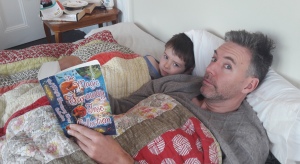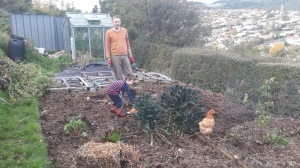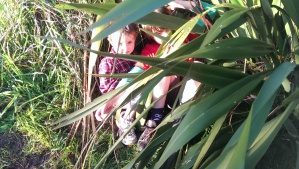I’ve posted a couple of fragments of this story already, but it’s growing.
After three days of rain, during which the mantle clock had stuck firm at twelve minutes past five, Henry took the clock down to the basement, laid it on its front, and removed the back panel. Inside the casing, metal lay in intricate order — coils, springs, a tiny hammer, round-headed pins. Henry hesitated, gently removed one coil, and then another.
The basement was cool and still, the brickwork buffering the noise from the house and the insistent drumming of the rain. Henry’s workbench ran along one wall, beneath a window blurred with dust. He kept the workbench tidy, his tools neatly packed away, and odds and ends — nails, screws, tacks, bolts — sorted into small jars, which he kept in a gridded shelf to the left of the window. He had a CD player down there, and sometimes played music as he worked, but today he was content with the quiet of empty space, its outer edges softly frayed with children’s voices, the distant hum of the dryer, rain.
There was a tap at the door, and Rachel poked her head around. “Lunch is almost ready, love,” she said. “What are you doing?” Henry started, took a step back. Rachel edged into the basement and joined him at the workbench. Together, they looked at the clock, its body empty and its parts scattered on the bench, mute and indecipherable as fossil bones. “Huh,” said Rachel. “Do you know how that all fits back together?” Henry contemplated the wreckage of the clock, felt a ball of panic and shame rise in his chest. Upstairs something thudded to the floor, followed by a moment of silence. Henry looked at Rachel, noted the soft creases starting to form around her mouth and eyes. A child’s voice rose, a loud, shocked cry filled more with outrage than with pain. “Oh for fuck’s sake,” said Rachel, and hurried outside. Henry bundled the clock pieces inside the casing and screwed the back on. As he walked towards the kitchen door, he could hear Rachel with the children, comforting them, negotiating the terms of peace, smoothing out their spiky discontent. Henry took a deep breath, pushed the clock to the back of his mind, and joined his family.
On Tuesday, the rain stopped, and Henry took the clock to the repairer, a compact, rumpled man with fine-boned hands. “I thought I’d have a go at fixing it,” he said, “but it didn’t really work. I’m sorry.” The repairer looked at him, measured him with a gaze sharpened from years of coaxing delicate mechanical objects into working order. Henry felt himself grow large and clumsy under the repairer’s gaze, an incompetent fool who knew no better than to blunder into the back of a clock as though it were nothing more complicated than a toaster or a child’s toy.
“These old clocks,” said the repairer, “they are so beautiful, no?” Henry nodded. He left his name and number, making his writing neat and taping the scrap of paper square on the top of the clock. The repairer said he would call in a day or two and Henry ducked out, found himself standing on the footpath, his hands empty, his shoulders easing in the sunshine.
It was a bright summer day in a quiet city, light falling on the hills and on people in the streets with equal and unstinting generosity. The air was sweet and warm, with that new smell that wears off as the sun lifts into the sky and the routine of the day takes over. But at that hour, it was as if the very leaves were rinsed in light, the leaves, and the asphalt too. He should get back to work, he knew, while the weather held. Mrs Lamberty’s garden was ready for planting, the beds shaped and filled with good rich soil. The plants were stacked against the back wall, his tools were in the car.
He turned the other way, set his face towards the distant sea, and started walking. It was a straight line to the beach. Block by block, the shops fell away, gave way to houses, square and worn, their window frames roughened by the salt wind, the gardens a straggle of weeds and toys. Henry’s stride lengthened. He could hear the waves now, their dull boom and crash on the sea wall. He lifted his head, smiled as a gull wheeled above him. He crossed the last road, climbed up the dunes, and stood on the crest. The light hit him, bright and uncompromising. The beach stretched long to either side, city at one end, rocks at the other. Henry bent down and tugged off his shoes and socks, wedged them behind a bush, rolled up his trousers, and walked down the sand dune, throwing his arms out as the momentum took him into a half-run.
____________________________________
The washing line was empty, and she liked it like that. She liked the unfilled space, the trees behind, the feeling that there was nothing there she needed to worry about. And the liberation was shared; she wasn’t parsimonious with her joy — the pigeon could shit right overhead if it liked, because no-one had their sheets out or their best shirt, and the rain could go right ahead and fall, fall as heavy as damn, fill the gutters and soak the plants, or settle about the house in a fine, drenching mist for all she cared, because there was nothing, not one thing, on the line.
But if not the washing, what was a girl to do? Rachel looked at her novel, contemplated the dishes in the sink, made a cup of tea. She felt adrift, cut loose in these suburban hills where the days drifted slow and peaceful like big old clouds.
She could run, she thought, start slow and build up speed until she crested the hill and launched herself into the sky with all the determined abandon of a hawk. She could circle there, held up by an air current, and look for answers in the green curved land beneath her, the thin little houses and the colour-splashed gardens, look for answers in the big blue luxury of the sky and the washing lines below—some of them empty, some carefully freighted with clean white sheets, scraps of underwear, socks in pairs, blue jeans, and a jersey, poppy red against the green.
Rachel took her tea and stepped into the garden, her feet leaving soft prints in the still-wet grass. The flowers were heavy with light-filled rain, the leaves bright, clean-edged. She leant against the old stone wall, pulled weeds from the pliant earth. She threw the weeds on the path, the pile scattering as she worked.
It was no good.
Rachel fetched a wheelbarrow, gathered the weeds and put them in. She moved on, filling and emptying the wheelbarrow, leaving the beds clean and fresh behind her. Dirt filled her nails, settled in the ridges and lines of her hands. She rubbed her nose and got some dirt in her mouth. It was bitter, mineral. Her back started to ache, that tender spot where her babies had pressed against her spine and where she wedged a pillow when she breastfed, or read. But she worked on, never looking too far ahead, narrowing her gaze on the little patch of ground in front of her until she was sure she had out every errant scrap of weed, then looking up, moving to the next patch, and the next.
























